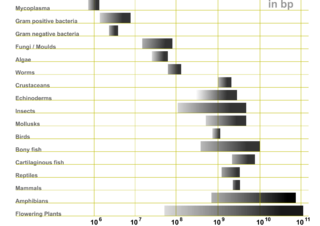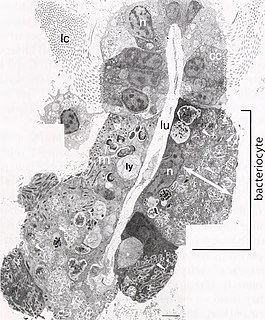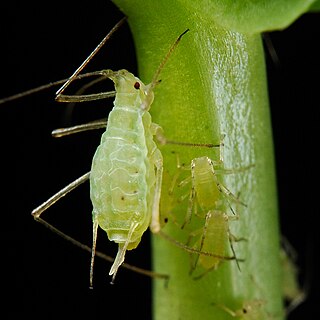
An endosymbiont or endobiont is any organism that lives within the body or cells of another organism most often, though not always, in a mutualistic relationship. (The term endosymbiosis is from the Greek: ἔνδον endon "within", σύν syn "together" and βίωσις biosis "living".) Examples are nitrogen-fixing bacteria, which live in the root nodules of legumes; single-cell algae inside reef-building corals, and bacterial endosymbionts that provide essential nutrients to about 10–15% of insects.

Aphids are small sap-sucking insects and members of the superfamily Aphidoidea. Common names include greenfly and blackfly, although individuals within a species can vary widely in color. The group includes the fluffy white woolly aphids. A typical life cycle involves flightless females giving living birth to female nymphs—who may also be already pregnant, an adaptation scientists call telescopic development—without the involvement of males. Maturing rapidly, females breed profusely so that the number of these insects multiplies quickly. Winged females may develop later in the season, allowing the insects to colonize new plants. In temperate regions, a phase of sexual reproduction occurs in the autumn, with the insects often overwintering as eggs.

Wolbachia is a genus of intracellular bacteria that infects mainly arthropod species, including a high proportion of insects, and also some nematodes. It is one of the most common parasitic microbes and is possibly the most common reproductive parasite in the biosphere. Its interactions with its hosts are often complex, and in some cases have evolved to be mutualistic rather than parasitic. Some host species cannot reproduce, or even survive, without Wolbachia colonisation. One study concluded that more than 16% of neotropical insect species carry bacteria of this genus, and as many as 25 to 70% of all insect species are estimated to be potential hosts.

Genome size is the total amount of DNA contained within one copy of a single complete genome. It is typically measured in terms of mass in picograms or less frequently in daltons, or as the total number of nucleotide base pair ed Mb or Mbp). One picogram is equal to 978 megabases. In diploid organisms, genome size is often used interchangeably with the term C-value.

Buchnera aphidicola, a member of the Proteobacteria, is the primary endosymbiont of aphids, and has been studied in the pea aphid, Acyrthosiphon pisum. Buchnera is believed to have had a free-living, Gram-negative ancestor similar to a modern Enterobacterales, such as Escherichia coli. Buchnera is 3 µm in diameter and has some of the key characteristics of their Enterobacterales relatives, such as a Gram-negative cell wall. However, unlike most other Gram-negative bacteria, Buchnera lacks the genes to produce lipopolysaccharides for its outer membrane. The long association with aphids and the limitation of crossover events due to strictly vertical transmission has seen the deletion of genes required for anaerobic respiration, the synthesis of amino sugars, fatty acids, phospholipids, and complex carbohydrates. This has resulted not only in one of the smallest known genomes of any living organism, but also one of the most genetically stable.

Aposymbiosis occurs when symbiotic organisms live apart from one another. Studies have shown that the lifecycles of both the host and the symbiont are affected in some way, usually negative, and that for obligate symbiosis the effects can be drastic. Aposymbiosis is distinct from exsymbiosis, which occurs when organisms are recently separated from a symbiotic association. Because symbionts can be vertically transmitted from parent to offspring or horizontally transmitted from the environment, the presence of an aposymbiotic state suggests that transmission of the symbiont is horizontal. A classical example of a symbiotic relationship with an aposymbiotic state is the Hawaiian bobtail squid Euprymna scolopes and the bioluminescent bacteria Vibrio fischeri. While the nocturnal squid hunts, the bacteria emit light of similar intensity of the moon which camouflages the squid from predators. Juveniles are colonized within hours of hatching and Vibrio must outcompete other bacteria in the seawater through a system of recognition and infection.

A bacteriocyte, also known as a mycetocyte, is a specialized adipocyte found primarily in certain insect groups such as aphids, tsetse flies, German cockroaches, weevils. These cells contain endosymbiotic organisms such as bacteria and fungi, which provide essential amino acids and other chemicals to their host. Bacteriocytes may aggregate into a specialized organ called the bacteriome.
Wigglesworthia glossinidia is a species of gram-negative bacteria which was isolated from the gut of the tsetse fly. W. glossinidia is a bacterial endosymbiont of the tsetse fly. Because of this relationship, Wigglesworthia has lost a large part of its genome and has one of the smallest known genomes of any living organism, consisting of a single chromosome of 700,000 bp and a plasmid of 5,200. Together with Buchnera aphidicola, Wigglesworthia has been the subject of genetic research into the minimal genome necessary for any living organism. Wigglesworthia also synthesizes key B-complex vitamins which the tsetse fly does not get from its diet of blood. Without the vitamins Wigglesworthia produces, the tsetse fly has greatly reduced growth and reproduction. Since the tsetse fly is the primary vector of Trypanosoma brucei, the pathogen that causes African trypanosomiasis, it has been suggested that W. glossinidia may one day be used to help control the spread of this disease.
Nancy A. Moran is an American evolutionary biologist and entomologist, University of Texas Leslie Surginer Endowed Professor, and co-founder of the Yale Microbial Diversity Institute. Since 2005, she has been a member of the United States National Academy of Sciences. Her seminal research has focused on the pea aphid, Acyrthosiphon pisum and its bacterial symbionts including Buchnera (bacterium). In 2013, she returned to the University of Texas at Austin, where she continues to conduct research on bacterial symbionts in aphids, bees, and other insect species. She has also expanded the scale of her research to bacterial evolution as a whole. She believes that a good understanding of genetic drift and random chance could prevent misunderstandings surrounding evolution. Her current research goal focuses on complexity in life-histories and symbiosis between hosts and microbes, including the microbiota of insects.
Cinara cupressi, the cypress aphid, is a brownish soft-bodied aphid. It sucks sap from twigs of conifers, and can cause damage to the tree, ranging from discoloring of the affected twig to the death of the tree. This insect appears to have originated in the Middle East and has been increasing its range and is considered to be an invasive species in Africa and Europe. It has been included in the List of the world's 100 worst invasive species.

Acyrthosiphon pisum, commonly known as the pea aphid, is a sap-sucking insect in the family Aphididae. It feeds on several species of legumes worldwide, including forage crops, such as pea, clover, alfalfa, and broad bean, and ranks among the aphid species of major agronomical importance. The pea aphid is a model organism for biological study whose genome has been sequenced and annotated.
The hologenome theory of evolution recasts the individual animal or plant as a community or a "holobiont" – the host plus all of its symbiotic microbes. Consequently, the collective genomes of the holobiont form a "hologenome". Holobionts and hologenomes are structural entities that replace misnomers in the context of host-microbiota symbioses such as superorganism, organ, and metagenome. Variation in the hologenome may encode phenotypic plasticity of the holobiont and can be subject to evolutionary changes caused by selection and drift, if portions of the hologenome are transmitted between generations with reasonable fidelity. One of the important outcomes of recasting the individual as a holobiont subject to evolutionary forces is that genetic variation in the hologenome can be brought about by changes in the host genome and also by changes in the microbiome, including new acquisitions of microbes, horizontal gene transfers, and changes in microbial abundance within hosts. Although there is a rich literature on binary host–microbe symbioses, the hologenome concept distinguishes itself by including the vast symbiotic complexity inherent in many multicellular hosts. For recent literature on holobionts and hologenomes published in an open access platform, see the following reference.
Cinara pilicornis, the spruce shoot aphid or brown spruce shoot aphid, is an aphid species in the genus Cinara found on Norway spruce and Sitka spruce. It is a quite large aphid species with a plump, dull brown body. It seems to have little effect on the tree. It is a European species but it has also been reported in spruce forests in New Zealand, together with the spruce aphid.
Pauesia is a genus of parasitoid wasps in the subfamily Aphidiinae. The species in the genus use the conifer aphids as their host.
Serratia symbiotica is a species of bacteria that lives as a symbiont of aphids. In the aphid Cinara cedri, it coexists with Buchnera aphidicola, given the latter cannot produce tryptophan. It is also known to habitate in Aphis fabae. Together with other endosymbionts, it provides aphids protection against parasitoids.
Hamiltonella defensa is a species of bacteria. It is maternally or sexually transmitted and lives as an endosymbiont of whiteflies and aphids, meaning that it lives within a host, protecting its host from attack. It does this through bypassing the host's immune responses by protecting its host against parasitoid wasps. However, H. defensa is only defensive if infected by a virus. H. defensa shows a relationship with Photorhabdus species, together with Regiella insecticola. Together with other endosymbionts, it provides aphids protection against parasitoids. It is known to habitate Bemisia tabaci.

Cospeciation is a form of coevolution in which the speciation of one species dictates speciation of another species and is most commonly studied in host-parasite relationships. In the case of a host-parasite relationship, if two hosts of the same species get within close proximity of each other, parasites of the same species from each host are able to move between individuals and mate with the parasites on the other host. However, if a speciation event occurs in the host species, the parasites will no longer be able to "cross over" because the two new host species no longer mate and, if the speciation event is due to a geographic separation, it is very unlikely the two hosts will interact at all with each other. The lack of proximity between the hosts ultimately prevents the populations of parasites from interacting and mating. This can ultimately lead to speciation within the parasite.

The giant mesquite bug is an insect of the order Hemiptera, or the "true bugs". As a member of the family Coreidae, it is a leaf-footed bug. As the common name implies, it is a large bug that feeds on mesquite trees of the American Southwest and Northwestern Mexico.

The Drosophila quinaria species group is a speciose lineage of mushroom-feeding flies studied for their specialist ecology, their parasites, population genetics, and the evolution of immune systems. Quinaria species are part of the Drosophila subgenus.
Vertical transmission of symbionts is the transfer of a microbial symbiont from the parent directly to the offspring. Many metazoan species carry symbiotic bacteria which play a mutualistic, commensal, or parasitic role. A symbiont is acquired by a host via horizontal, vertical, or mixed transmission.












